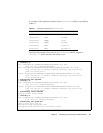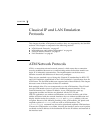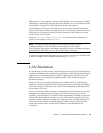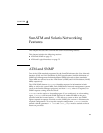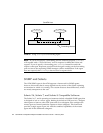
Chapter 7 Classical IP and LAN Emulation Protocols 69
Although the a entry requires a complete ATM address, you can reference multiple
addresses in a single entry using the provided wildcards. See “Using Variables in the
aarconfig File” on page 47 for more information about this feature.
The advantage of having an ATM ARP server in the subnet is that it represents a
known source for all address resolutions. It is the only host that a client must know
about to have IP addresses resolved to ATM connections, and it allows for access
control in the ATM network.
When the /etc/opt/SUNWconn/atm/aarconfig file has been modified on a
system, it is necessary to rerun aarsetup.
Note – For better caching, all clients have the option of adding to their
configuration file the IP-to-ATM address information for other clients.
This can benefit clients that communicate frequently because it eliminates having to
go through the ATM ARP server for IP-to-ATM address resolution.
If a host has multiple SunATM cards, the host can be a server for one IP subnet and
a client for another. This is handled transparently by aarsetup.
LAN Emulation
As described in previous sections, Classical IP provides its own (IP-to-ATM) address
resolution mechanism that corresponds to and replaces ARP, thus allowing IP-based
applications to run transparently over ATM. A shortcoming of Classical IP, and a
primary reason it must replace the traditional ARP, is that it does not support
broadcast messages.
Because ATM is a connection-oriented protocol (unlike ethernet), implementing
broadcast is much more difficult. The only host that receives a message is the host to
which the message is addressed, and a call must be established to that host before
the message can be sent.
Local area network (LAN) Emulation, as standardized by the ATM Forum, provides
mechanisms to send broadcast messages in an ATM environment. Given this
capability, LAN Emulation is also able to work transparently with ARP, as well as IP.
IP and ARP send broadcast messages over the ATM interface, and thus resolve IP
addresses to MAC addresses; messages are then sent to the LAN Emulation driver,
which has its own address resolution protocol (similar to that of Classical IP) to
resolve the medium access control (MAC) address to an ATM address and
connection.





